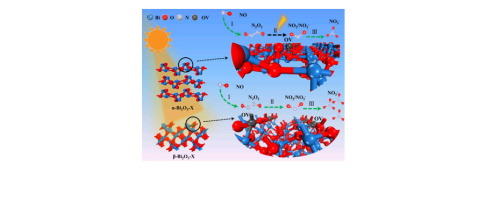Science Bulletin ( IF 18.8 ) Pub Date : 2020-01-10 , DOI: 10.1016/j.scib.2020.01.007 Ben Lei , Wen Cui , Jianping Sheng , Hong Wang , Peng Chen , Jieyuan Li , Yanjuan Sun , Fan Dong

|
This work unraveled the synergistic effects of crystal structure and oxygen vacancy on the photocatalytic activity of Bi2O3 polymorphs at an atomic level for the first time. The artificial oxygen vacancy is introduced into α-Bi2O3 and β-Bi2O3 via a facile method to engineer the band structures and transportation of carriers and redox reaction for highly enhanced photocatalysis. After the optimization, the photocatalytic NO removal ratio on defective β-Bi2O3 was increased from 25.2% to 52.0% under visible light irradiation. On defective α-Bi2O3, the NO removal ratio is just increased from 7.3% to 20.1%. The difference in the activity enhancement is associated with the different structure of crystal phase and oxygen vacancy. The DFT calculation and experimental results confirm that the oxygen vacancy in α-Bi2O3 and β-Bi2O3 could promote the activation of reactants and intermediate as active centers. The crystal structure and oxygen vacancy could synergistically regulate the electrons transfer pathway. On defective β-Bi2O3 with tunnel structure, the reactants activation and charge transfer were more efficient than that on α-Bi2O3 with zigzag-type configuration because of the defect structures on the surface of α-Bi2O3 and β-Bi2O3 were different. Moreover, the in situ FT-IR revealed the mechanisms of photocatalytic NO oxidation. The photocatalytic NO conversion pathway on α-Bi2O3 and β-Bi2O3 can be tuned by the different surface defect structures. This work could provide a novel strategy to regulate the photocatalytic activity and conversion pathway via the synergistic effects of crystal structure and oxygen vacancy.
中文翻译:

晶体结构和氧空位对Bi 2 O 3多晶型物的协同作用:中间体活化,光催化反应效率和转化途径
这项工作首次揭示了原子结构上晶体结构和氧空位对Bi 2 O 3多晶型物光催化活性的协同作用。人工氧空位引入α-Bi系2 ö 3和β-Bi系2 ö 3经由简便方法工程师高度增强光催化能带结构和载体的运输和氧化还原反应。优化后,对有缺陷的β-Bi系光催化NO除去率2 ö 3是从25.2%可见光照射下增加至52.0%。上有缺陷的α-Bi系2 ö 3,NO去除率仅从7.3%增加到20.1%。活性增强的差异与晶体相和氧空位的不同结构有关。在DFT计算和实验结果确认,在α-Bi系中的氧空位2 ö 3和β-Bi系2 ö 3可以促进反应物的活化和中间作为活性中心。晶体结构和氧空位可以协同调节电子转移途径。上有缺陷的β-Bi系2 ö 3与隧道结构,反应物活化和电荷转移均高于上更有效的α-Bi系2 ö 3因为与α-Bi系的表面上的缺陷结构的锯齿形结构2 ö 3和β-Bi系2 ö 3是不同的。而且,原位FT-IR揭示了光催化NO氧化的机理。对α-Bi系的光催化NO转换途径2 ö 3和β-Bi系2 ö 3可以通过不同的表面缺陷结构来调节。这项工作可以提供一种新的策略,通过晶体结构和氧空位的协同效应来调节光催化活性和转化途径。











































 京公网安备 11010802027423号
京公网安备 11010802027423号